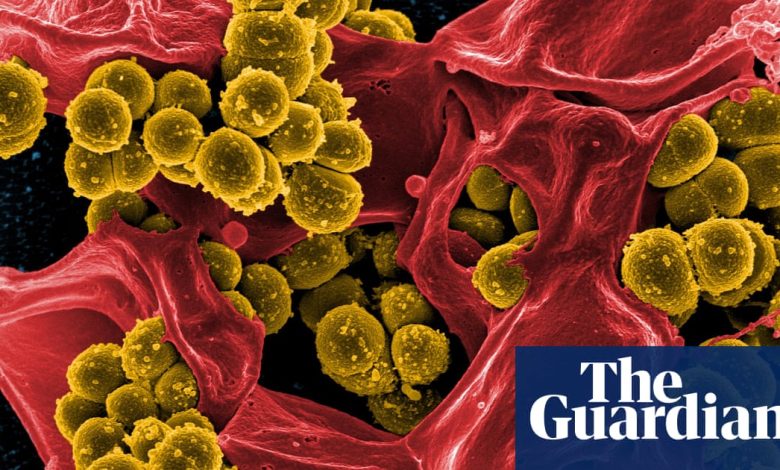AI used to predict potential new antibiotics in groundbreaking study | Antibiotics

A new study uses machine learning to predict potential new antibiotics in the global microbiome, which the study authors say marks a significant advance in the use of AI in antibiotic resistance studies.
The report, published Wednesday in the journal Cell, details the findings of scientists who used an algorithm to mine “all the microbial diversity we have on earth—or a vast representation of it—and find nearly 1 million new molecules encoded or hidden in all this microbial dark matter,” said Cesar de la Fuente, study author and professor at the University of Pennsylvania. De la Fuente directed Machine Biology Groupwhich aims to use computers to accelerate discoveries in biology and medicine.
Without such an algorithm, De la Fuente said, scientists would have to use traditional methods like collecting water and soil to find molecules in those samples. This can be a challenge because microbes are everywhere, from the ocean to the human gut.
“It would have taken many, many, many, many years to do this, but with an algorithm we can sort through massive amounts of information and it just speeds up the process,” De la Fuente said.
The research is urgent for public health, the author said, because antimicrobial resistance causes more than 1.2 million deaths in 2019. That number could increase to 10 million deaths a year by 2050, according to World Health Organization (WHO).
Although De la Fuente said he sees the study, which led to “the largest antibiotic discovery effort ever,” as a watershed moment in the potential benefits of artificial intelligence for research, he acknowledged that bad actors could potentially ” to develop AI models for designing toxins“.
He said his lab had put precautions in place to store them and ensure that the molecules could not reproduce themselves. It should be noted that biosafety precautions were not necessary for this study as these were “inert molecules”.
While artificial intelligence has become a hot topic in recent years, De la Fuente said he began using AI in antibiotic research about a decade ago.
“We were able to just accelerate the discovery of antibiotics,” De la Fuente said. “So instead of having to wait five, six years to come up with one candidate, now, on the computer, we can come up with hundreds of thousands of candidates in just a few hours.”
Before the US Food and Drug Administration approves an antibiotic, it usually goes through years of study through laboratory research and clinical trials. These different stages it can take 10 to 20 years.
For this study, the researchers assembled genomes and metagenomes stored in publicly available databases and looked for fragments of DNA that might have antimicrobial activity. To confirm these predictions, they used chemistry to synthesize 100 of these molecules in the lab and then tested them to determine whether they could actually kill bacteria, including “some of the most dangerous pathogens in our society,” said De la Fuente.
79% of the molecules, which are representative of the 1 million molecules discovered, can kill at least one microbe – meaning they can serve as a potential antibiotic.
Antibiotic resistance is a growing concern due to the misuse and overuse of antimicrobials in humans, animals and plants, according to the WHO.
The study’s authors have made this data and code freely available for anyone to access in order to “advance science and benefit humanity,” De La Fuente said.
after the promotion of the newsletter
He hopes his team and other researchers will further investigate the best candidates for potential antibiotic drugs. “Then, if that goes well, it will go into phase one clinical trials, but we’re still a long way from that,” he said.
This is not the first research in biology to make significant use of AI. Google DeepMind recently released the latest version of AlphaFoldprogram that predicts how proteins will interact with other molecules and ions, which could lead to breakthroughs in fields as diverse as cancer therapy and crop resistance.
Lisa Messery, an anthropologist of technology at Yale University, said that machine learning and AI are “certainly great for some projects in science,” but not for all.
“We simply ask that researchers and research programs continue to exercise caution when they decide to apply these methods, and not limit projects that do not necessarily require the use of these highly touted and focused tools,” she said.
Some have raised concerns about AI, including that it could replace humans in certain jobs — particularly in conducting scientific research.
De la Fuente argues that AI will involve collaboration between humans and machines.
Anthony Gitter, an associate professor of biostatistics and medical informatics at the University of Wisconsin-Madison who uses machine learning in biological experiments, says the “significance of progress” in the Cell report “is due to first-rate research in bioinformatics, as opposed to automated science enabled by AI”.
“The significance of this study is that it successfully uses widespread microbial genomic data, uses machine learning to identify candidate antimicrobial peptides, and thoroughly studies these predicted peptides computationally and experimentally to show why they are valuable,” Gitter said.




